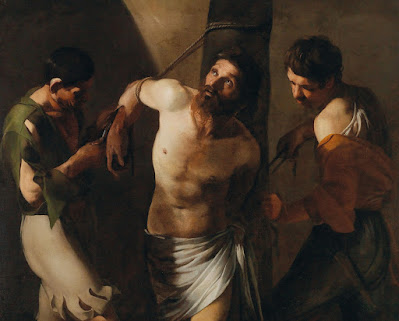 |
| Caravaggio Crucifixion of St Peter ca. 1600 oil on canvas Cerasi Chapel, Basilica di Santa Maria del Popolo, Rome |
 |
| Luca Giordano Crucifixion of St Peter ca. 1660 oil on canvas Gallerie dell' Accademia, Venice |
 |
| Carlo Dolci St Andrew praying before his Martyrdom 1643 oil on canvas Birmingham Museum and Art Gallery, West Midlands |
 |
| Pietro Novelli (Il Monrealese) Martyrdom of St Bartholomew ca. 1630 oil on canvas Pinacoteca Civica di Reggio Calabria |
 |
| Bartolomeo Manfredi Martyrdom of St Bartholomew before 1622 oil on canvas private collection |
 |
| Gioacchino Assereto Martyrdom of St Bartholomew ca. 1630 oil on canvas Accademia Ligustica di Belle Arti, Genoa |
 |
| Orazio Borgianni Martyrdom of St Erasmus ca. 1610 oil on canvas private collection |
"In the apt diagnosis of Maud Gleason, Roman criminal justice "may have presented to its subjects a face as arbitrary, as inexplicable, even as malign – as Fortuna herself. But its very incomprehensibility comprehended a message. Arbitrariness is an effective way to dramatize power." Unlike a modern court, in which the trial seeks to clarify truth through what Robert Burns has called a "consciously structured hybrid of languages and performances," Roman criminal trials were spectacles that dramatized the power of the state. They were held publicly, attracting mobs of spectators to see the state and the criminal square off in a battle that the state was supposed to win. They deployed spectacular and arbitrary violence against the body of the condemned. By using violence to constitute legal truth, and by impressing on the minds of spectators the state's power to harm, these courtroom rituals contributed to governance, if perhaps in a sinister fashion."
"Bound up in the violent spectacle of Roman criminal justice was a claim about imperial power, specifically, the claim that representatives of the imperial state were justified in punishing because they possessed a privileged form of knowledge, namely, the ability to evaluate the goodness and rightness (or the badness and wrongness) of a defendant by means of physical signs. In other words, criminal judgment was bound up with the state's claim to be able to tell, by looking, who is decent and who is criminal."
"We feel distaste not because we do not share Roman judgments of what is beautiful and ugly. We are troubled instead because the procedures for arriving at such a verdict cannot be reduced to sets of rules. They can only be inculcated by processes of habituation, by participation in a "shared grammar of concepts." Their resistance to becoming rule-bound makes them fundamentally un-juridical, at least in the modern sense of the term. They sit exclusively within communities, or are imposed upon a subordinate community at the behest of a hegemonic group and then naturalized through processes of habituation. Our rational discourse of scholarship is inadequate for capturing the emotional force of these intuitive judgments. Yet we nonetheless feel them when we read descriptions of the state punishing a criminal and staging his wounded body as a gruesome tableau to which it contrasts its own rightness (as knowing judge), and then uses these images (of rightness or of horror) as a demonstration that the state has come to the correct answer in the first place. Such is the power of aesthetics, and similarly a reason why these intuitive judgments are intimately connected to violence."
– from an article by Ari Bryen, Martyrdom, Rhetoric, and the Politics of Procedure, published in the journal Classical Antiquity (October 2014)
 |
| Valentin de Boulogne Martyrdom of St Processus and St Martinian 1629 oil on canvas Pinacoteca Vaticana, Rome |
 |
| Alessandro Turchi Martyrdom of St Agnes 1620 oil on canvas Castello del Buonconsiglio, Trento |
 |
| Pietro Ricchi (Il Lucchesino) Martyrdom of St Christina of Bolsena before 1675 oil on canvas Pinacoteca Egidio Martini, Ca' Rezzonico, Venice |
 |
| Domenichino Martyrdom of St Peter of Verona (detail) ca. 1619-21 oil on canvas Pinacoteca Nazionale di Bologna |
 |
| Jacopo da Empoli (Jacopo Chimenti) Martyrdom of St Sebastian ca. 1620 oil on canvas Basilica di San Lorenzo, Florence |
 |
| Pietro della Vecchia Martyrdom of St Sebastian 1654 oil on canvas Pinacoteca Civica, Treviso |
 |
| Biagio Manzoni Martyrdom of St Sebastian before 1635 oil on canvas Musée du Louvre |
 |
| Antonio Molinari St Sebastian and St Irene ca. 1695 oil on canvas Hermitage. Saint Petersburg |